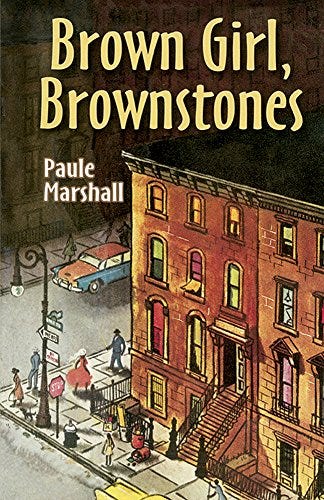Rookie Season: Debuts
Extra seasoning for your everyday food for thought
Genre: Coming-of-Age, Domestic Fiction
“‘The world takes more than its pound of flesh sometimes. It’s devised all kinds of torture, the most exquisite being a colossal indifference.’”
— Paule Marshall
Brown Girl, Brownstones, the debut novel by internationally acclaimed writer Paule Marshall, published in 1959 and dramatized in 1960 by a CBS Repertoire Workshop TV program starring Cicely Tyson1, is a story of Barbadian immigrants everyday living in Brooklyn, New York, during the Great Depression and the beginning of the Second World War.
Selina Boyce is torn—dear-heart!—she caught between a rock and a hard place, between sympathy for her hard-working, ambitious mother, Silla, (who desperately longs to buy a brownstone house and, thus, be accepted in their new foreign country) and a deep love for her easy-going, romantic father, Deighton (who instead longs to return to their lush native island homeland). The plot thickens when her father, Deighton, inherits land in their home country of Barbados. Selina’s mother, concerned with her husband’s dastardly ways, and in no way interested in returning to the islands, attempts to clandestinely reap the inheritance in order to purchase a family brownstone in Brooklyn by forging letters to Deighton's sister and granting her power of attorney to sell his land and grab the cash. Selina overhears the plan, but Silla threatens to punish if she tells. In the end, it doesn’t matter as Deighton squanders the cash from the land sale anyway, alienating himself and the family further from their tight-knit, immigrant community. As Deighton falls deeper into depression and shame, he severely injures his arm at a factory job. He subsequently joins a cult, shortly after the factory incident, denouncing his entire family. Wounded and hurt, Silla (in anger) contacts the authorities to have Deighton deported. Months later, the family receives news that Deighton either jumped or fell off a ship headed back to Barbados, drowning to his untimely death. Selina never forgives her mother’s treachery (blaming her mother for her father’s early demise), and the remainder of the novel charts the two women’s complex relationship, as Selina grows into young womanhood, forging her own identity, sexuality, and sense of values. But as fate would suggest for poor Selina (as she struggles to assimilate as a young Black woman in America herself, forced to live with the consequences of her own impossible choices), learning that she ain’t so different from her mother may be the most challenging growing pains of them all.
Paule Marshall (April 9, 1929) was born Valenza “Pauline” Burke in Brooklyn, New York, to Adriana Viola Clement Burke and Sam Burke. Marshall’s father migrated from the Caribbean island of Barbados to New York in 1919 and, during her childhood, deserted the family to join a quasi-religious cult, leaving his wife alone to raise their children. A thirteen year old Marshall, smitten with author and poet Paul Laurence Dunbar,
changed her middle name from Pauline to Paule (with a silent “e” - pronounced Paul) in order to cope. Despite the family’s numerous setbacks, mishaps, and obstacles, Marshall’s writing talent was undeniable—revealing itself early. Throughout a storied career and exceptional life, Paule Marshall was the recipient of several prestigious awards, including a MacArthur Foundation Fellowship (aka “The Genius Grant” in 1992)2, a Guggenheim Fellowship, and various grants from the Ford Foundation and the US National Endowment for the Arts3
“‘The funny feeling you get is that they don’t really see you. It’s very eerie and infuriating. For a moment there until everybody suddenly got friendly I felt like I didn’t exist but was only the projection of someone or something else in their mind’s eye.’”
– Paule Marshall, Brown Girl, Brownstones
Did You Know?
Did you know that due to popular demand, twenty-two years after its first publishing, Brown Girl, Brownstones was reprinted by the Feminist Press in 1981? At the time, Marilee Talman, a consultant to the feminist nonprofit, said, “It is the title we have been urged to reprint more often than any other.”4
Tell Me More . . .
Fun fact! Given the novel’s considerable notoriety, original artwork was chosen by renowned Brooklyn artist Ernest Crichlow (who like Marshall was born to Barbadian immigrants in New York) to adorn the 1981 reprint cover.
Some Food For Thought:
BTW - The mere fact that this 1959 debut novel about a modest young, foreign, and Black immigrant woman has stood the test of time, while still widely critiqued and read to this day, is quite remarkable. In fact, in a 1998 essay titled, “The Sea Ain’ Got No Back Door” researcher and educator Gavin Jones suggested, “The predominant theme of Brown Girl is not invisibility but the problems of vision that are experienced by a central character who sees the world—and her own blackness—from a number of different perspectives: as an African American, a Barbadian immigrant, and a woman.” And yet, in Marshall’s own words, she remarked, “My mother and her friends were after all the female counterparts of Ralph Ellison’s invisible man [1952]. Indeed, you might say they suffered a triple invisibility, being black, female, and foreigner.”5
Rookie Season: Debuts
A STEM Grew Petals Newsletter
Next issue is N. K. Jemisin - The Hundred Thousand Kingdoms:
Want Daily Quotes?
Follow on Instagram (at Captioned Black Art)
Made in Silicon Valley (with love) by author Jafari Joseph.
Copyright (C) 2024 My STEM Grew Petals Publishing. All rights reserved.
STEM Grew Petals is a reader-supported publication. To receive new posts and support my work, consider becoming a free or paid subscriber.
https://www.arts.gov/sites/default/files/NEA_lit.pdf (ref. page 30)






